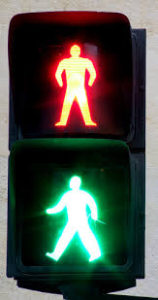 Somebody decided to turn the world into ones and zeroes, and thus began the digital revolution. Such a simple idea. It’s either this or that. Maybe the world really is black and white. Maybe that whole idea that I have lived by all these years, that life is really analog, that understanding others and oneself is all about appreciating the subtlest shades of gray, the overlap between good and evil, the mysteries residing in the spaces between the lines, the sweet paralysis of ambiguity—maybe I had it all wrong.
Somebody decided to turn the world into ones and zeroes, and thus began the digital revolution. Such a simple idea. It’s either this or that. Maybe the world really is black and white. Maybe that whole idea that I have lived by all these years, that life is really analog, that understanding others and oneself is all about appreciating the subtlest shades of gray, the overlap between good and evil, the mysteries residing in the spaces between the lines, the sweet paralysis of ambiguity—maybe I had it all wrong.
Maybe the analog life is the illusion after all. It really is now or never, and the hackneyed question “if not now, when?” really has currency. Life would be so much simpler, wouldn’t it, if a person was all good or all evil, or if you are either in love or out of it, and if there really were only two sides to every story. After all, it is probably indisputable that a person can’t be in two places at the same time, unless of course you’re struggling with one of Zeno’s paradoxes, in which case you might dispute the notions of place and time altogether.
Pilots call it the “go-no go decision.” You either takeoff or you stay home. It’s that simple. As the paean to binariness that Rosie taught me goes: whether you like the weather you got, you gotta have weather, whether or not. And if the weather is good enough, the airplane is working correctly, and you are physically and mentally capable, you go. You crank up that engine and open the throttle and start rolling. Or else, you go home, open a bag of potato chips, and watch TV or read a book. It’s that simple. Ones and zeroes.
Now, I have nothing against ones and zeroes themselves; in fact, the invention of the zero, probably by ancient Olmecs in Mexico, is a milestone in mathematical history. Even the ancient Greeks, who came later, struggled with the concept, wondering how nothing can actually be something, a question which many self-doubting adolescents ask themselves daily.
The notion of one, and its philosophical sibling oneness, is perhaps the biggest concept of all. I would go so far as to say that the number one is like my friend Stephanie’s cheesecake– which is so delicious that it’s probably too sinful to eat, in that the number one is so profound that it’s probably too sinful to even talk about. It is, in Judaism, arguably the definition of God itself, in that every Jewish house has a little scroll wrapped up in a decorative case and affixed to the door that starts with the words—printed in larger type than the rest of the biblical excerpt: “Hear oh Israel, the Lord is God, the Lord is One.” “Is” is the verbal representation of the mathematical “equals” sign, which is to say that, based on the principle of commutation, the Lord, God and the number One are all the same.
But while I have no problem with ones and zeroes, I also really like a lot of other numbers. Thirteen, for example, has always been lucky for me. Three is particularly romantic, and frankly quite mystical, being associated with the holy trinity and managing to represent both three gods and one simultaneously, while a lot of people believe that the third time you do something is “the charm.”
The magic of the digital revolution, I suppose, is the particular kind of alchemy that arises by stringing a bunch of ones and zeroes together into a byte, which as all you computer geeks know is eight bits. A bit is a portmanteau for “binary digit,” which is generally coded as a one or a zero. When you string together eight ones or zeroes, you can create all the letters of the alphabet, and a whole lot more. But in order to do that, you are still bit-dependent, and so you still, ultimately, exist in a reductionistic, binary world. No computer geeks worth their weight in kilobytes will tell you that the number eight is magical, because they know that it all really boils down to stringing together a series of binary digits. Binary is where it’s at.
So the fact that you can perceive color or shades of gray on a computer screen is really an illusion based on making ones and zeroes dance to a programmer’s tune. Perhaps the purple salvia, brown rocks, light green and yellow leaves on the koelreuteria tree outside my window are all an illusion too, constructed out of bits of ones and zeroes, a carbon atom here or not, a bit of silicon or an empty space. Maybe the yearning to see my kids, the anticipation of an adventure, or the thrill of my airplane lifting off the earth is nothing more than a series of ones and zeroes, an electron jumping from one neuron to another or not.
I am, after all, either going to stop writing this now and check my email, or continue. I am going to pour another cup of coffee before it gets too cold in the press, or not. I am going to face the chill of this Monday morning and get my ass off this chair, or I am going to sit here longer and try to craft something that you will enjoy reading, or I am going to get off my ass and unpack the backpack full of hopefully income-producing paperwork and have at it or not. It’s go or no-go, now or never, this or that, yes or no. The rest is an illusion.




 My yoga instructor, Charles DeFay, is a kind, well-intentioned man, who is undoubtedly sincere in his beliefs, despite delivering his instructions a bit like a drill sergeant on Ritalin. He repeats the same phrases along with the asanas (the positions) in each session; sometimes the phrases serve as punctuation, but just like the asanas, they are always the same.
My yoga instructor, Charles DeFay, is a kind, well-intentioned man, who is undoubtedly sincere in his beliefs, despite delivering his instructions a bit like a drill sergeant on Ritalin. He repeats the same phrases along with the asanas (the positions) in each session; sometimes the phrases serve as punctuation, but just like the asanas, they are always the same.


